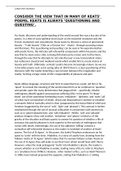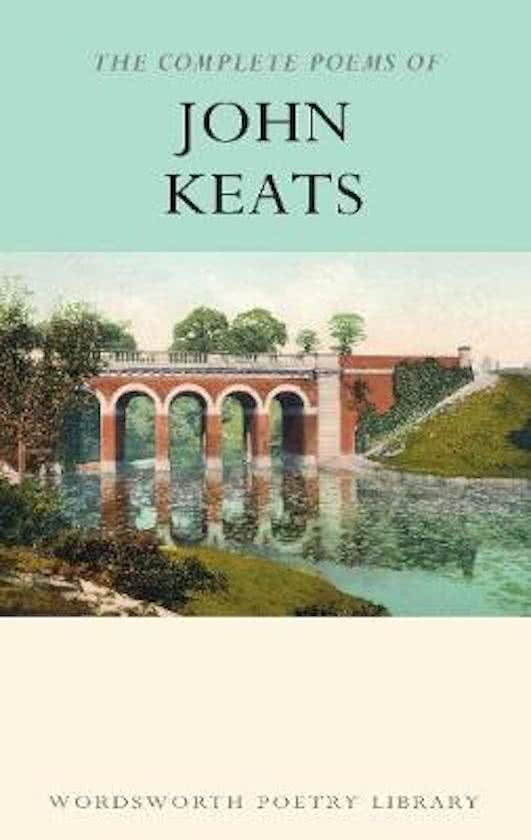Caitlyn-Ann Shortland
CONSIDER THE VIEW THAT IN MANY OF KEATS’
POEMS, KEATS IS ALWAYS ‘QUESTIONING AND
QUESTING’.
For Keats, discovery and understanding of the world around him was a key aim of his
poetry. In a time of socio-political strain (such as the industrial revolution and the
French revolution) and romanticism, Keats wants to discover a vision of permanent
beauty – ‘Truth beauty’ (‘Ode on a Grecian Urn’ - Keats) - through accessing nature
and literature. This ‘questioning and questing’ can be seen in his experimentation
with poetic forms, the intricate self-referential components within his poems and the
way that he views every state as being dichotomous by nature and, furthermore,
through the way that he attempts to not only discover a new transcendent vision,
but rediscover classical and medieval words which enable him to create visions of
beauty and truth. Ultimately, as Keats’ poetry became increasingly mature (as we see
in his latter poems such as his spring odes of 1819) there is a clear questioning of this
discovery with the reader detecting a new tension between the imagination and
reality, forming a tragic vision of life’s inseparability of pleasure and pain.
Keats utilises language, structure and form to experiment as a poet, aid him in his
‘quest’ to unravel the meaning of the world around him as he continues to ‘question’
and ponder upon the many dichotomies that plagued him – specifically, blissful
nothingness (death) against sensuousness suffering (life). In his poem ‘To Sleep’,
Keats’ use of the somewhat foreboding nouns ‘embalmer’, ‘darkness’ and ‘woes’ (all
of which have connotations of death, dread and despondence) combine to establish
a semantic field of mortality which is then juxtaposed by the lexical field of relief and
freedom (suggested by the use of ‘soft’, ‘light’ and ‘pleased’). This contrast is further
emphasised through the use of unusual collocation in conjunction with oxymorons
such as in ‘gloom-pleased eyes’ and ‘soft embalmer’. Whilst, ‘soft’ and ‘pleased’
produce imagery of joy and comfort, ‘embalmer’ and ‘gloom’ remind us of the
gravity of the situation and Keats quests to answer his question of whether a life of
sensuous but painful pleasure is truly superior to the serenity of nothingness that
comes with death. Interestingly, the use of the adjective ‘willing’ contains a
somewhat self-referential element as the reader is reminded of another of Keats’
poems, The Eve of St Agnes’. In this poem, the lustful Porphyro endeavours on his
quest to ‘unite’ with his lover, Madeline, in a story of courtly love, drawing from the
folklore myths of ‘St Agnes’ (which states that if a woman follows certain rituals on
the eve of St Agnes they will wake to see their lover whom would feast with them).
However, when the male protagonist ‘melts’ into Madeline’s dream, the reader is
unsure whether or not Madeline is awake, leading many critics to refer to Porphyro
as a ‘predatory hero’ (Miller). However, other modern critics, such as Heidi Thomson
in 1988, have instead proposed the opposite, stating that Madeline is a ‘willing
, Caitlyn-Ann Shortland
participant in her seduction’. This concept of ‘seduction’ is present in the majority of
Keats’ poems, from being ‘lulled to sleep’ in both ‘To Sleep’ and ‘La Belle Dame Sans
Merci’ to the entrancing nature of the nightingale’s song in ‘Ode to a Nightingale’. In
the case of ‘To Sleep’ the narrators ‘willingness’ to give into this ‘Soothest Sleep’
seems to mirror a sense of giving into sin, which, in this instance, could be seen as
the ‘darkness’. Perhaps, this association of willing death and darkness could be
somewhat linked to the god-fearing nature of early 19th century England whom
would have considered suicide to be sinful and against the will of God. Interestingly,
in most of his other poems, this ‘willing’ seduction seems to be associated with a
source of pleasure. Perhaps, it is plausible that, in this poem, death is treated as a
source of pleasure – an escape. In the poem, Keats alludes to death using
euphemisms such as ‘soothest sleep’. Here, the use of soft sibilance of the ‘s’ sounds
combined with the superlative adjective ‘soothest’ combine to create a light and
tranquil atmosphere for the reader. In this instance, the poet does not wish to
present death as a sinister force, it is a means of access to a peaceful and sensuous
state. During the time that he wrote this poem, Keats was dying from tuberculosis
and was suffering from a great deal of pain, perhaps here we see Keats’
contemplation on the painful and cruel nature of life and the supposed relief that
death would bring.
Moreover, during this time, Keats became somewhat obsessed with an idea that he
coined as ‘Negative capability’. The poet wrote in his letters that he quested to
become a ‘dreamer’ but his ‘dull brain’ imprisoned him in the role of a ‘thinker’ and,
only through sleep, is he allowed to venture into the untainted realm of ‘imagination’
– as discussed by critics Samuel C. Chew and Richard D Altick in 1948 who argued
that Keats’ poetry represents a ‘quest of a unity transcending the flux of the
phenomenal and physical world’. The continual use of contrasts, juxtaposition and
antithesis within Keats’ poems creates a sense of ambiguity for the reader which acts
as an insight into the mind of the great John Keats as the reader is able to experience
his questioning of every attribute of reality. The poet aims to create this ambiguity
for the reader to allow them to contemplate on these very same questions and
reciprocate Keats’ all-consuming desire to discover meaning in a meaningless and
chaotic world, he does not just want us to witness his questioning of reality but
rather to encourage his readers to become inquisitive and join him in his ‘questing
and questioning’.
However, notably, in this poem, unlike many of his other works, Keats appears to
discover an answer to his question. After the narrator cries that they wish to be
‘saved from their ‘curious consciousness’ there is a noticeable slowing of the pace of
the poem – with the last line of the poem consisting of almost all monosyllables
(slowing the pace of the poem when read aloud). This slowing of the pace appears to
mimic the process of ‘death’ or ‘sleep’ and allows the reader to reciprocate the poets
dreariness as he is ‘lulled’ into unconsciousness. Interestingly, the one word to break





